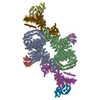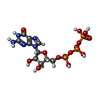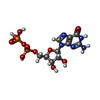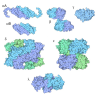+ Open data
Open data
- Basic information
Basic information
| Entry | Database: PDB / ID: 6sb2 | ||||||||||||
|---|---|---|---|---|---|---|---|---|---|---|---|---|---|
| Title | cryo-EM structure of mTORC1 bound to active RagA/C GTPases | ||||||||||||
 Components Components |
| ||||||||||||
 Keywords Keywords | SIGNALING PROTEIN / small GTPases / mTORC1 activator / roadblock domain / GTPase domain | ||||||||||||
| Function / homology |  Function and homology information Function and homology informationGtr1-Gtr2 GTPase complex / FNIP-folliculin RagC/D GAP / RNA polymerase III type 2 promoter sequence-specific DNA binding / RNA polymerase III type 1 promoter sequence-specific DNA binding / positive regulation of cytoplasmic translational initiation / regulation of locomotor rhythm / T-helper 1 cell lineage commitment / positive regulation of pentose-phosphate shunt / positive regulation of wound healing, spreading of epidermal cells / TORC2 signaling ...Gtr1-Gtr2 GTPase complex / FNIP-folliculin RagC/D GAP / RNA polymerase III type 2 promoter sequence-specific DNA binding / RNA polymerase III type 1 promoter sequence-specific DNA binding / positive regulation of cytoplasmic translational initiation / regulation of locomotor rhythm / T-helper 1 cell lineage commitment / positive regulation of pentose-phosphate shunt / positive regulation of wound healing, spreading of epidermal cells / TORC2 signaling / TORC2 complex / regulation of membrane permeability / regulation of TORC1 signaling / cellular response to leucine starvation / negative regulation of lysosome organization / heart valve morphogenesis / TFIIIC-class transcription factor complex binding / TORC1 complex / voluntary musculoskeletal movement / positive regulation of transcription of nucleolar large rRNA by RNA polymerase I / protein localization to lysosome / positive regulation of odontoblast differentiation / calcineurin-NFAT signaling cascade / RNA polymerase III type 3 promoter sequence-specific DNA binding / positive regulation of keratinocyte migration / regulation of osteoclast differentiation / regulation of lysosome organization / regulation of TOR signaling / MTOR signalling / cellular response to nutrient / cellular response to L-leucine / energy reserve metabolic process / regulation of autophagosome assembly / Energy dependent regulation of mTOR by LKB1-AMPK / Amino acids regulate mTORC1 / TORC1 signaling / ruffle organization / serine/threonine protein kinase complex / cellular response to methionine / positive regulation of osteoclast differentiation / negative regulation of cell size / positive regulation of ubiquitin-dependent protein catabolic process / cellular response to osmotic stress / negative regulation of protein localization to nucleus / anoikis / inositol hexakisphosphate binding / protein localization to membrane / cardiac muscle cell development / negative regulation of calcineurin-NFAT signaling cascade / regulation of myelination / positive regulation of transcription by RNA polymerase III / small GTPase-mediated signal transduction / negative regulation of macroautophagy / Macroautophagy / positive regulation of myotube differentiation / regulation of cell size / Constitutive Signaling by AKT1 E17K in Cancer / positive regulation of actin filament polymerization / germ cell development / TOR signaling / behavioral response to pain / mTORC1-mediated signalling / oligodendrocyte differentiation / positive regulation of oligodendrocyte differentiation / positive regulation of translational initiation / protein serine/threonine kinase inhibitor activity / social behavior / protein kinase activator activity / CD28 dependent PI3K/Akt signaling / HSF1-dependent transactivation / positive regulation of TOR signaling / regulation of macroautophagy / enzyme-substrate adaptor activity / positive regulation of G1/S transition of mitotic cell cycle / response to amino acid / 'de novo' pyrimidine nucleobase biosynthetic process / positive regulation of epithelial to mesenchymal transition / vascular endothelial cell response to laminar fluid shear stress / positive regulation of lipid biosynthetic process / heart morphogenesis / cellular response to nutrient levels / neuronal action potential / regulation of cellular response to heat / positive regulation of lamellipodium assembly / cardiac muscle contraction / phagocytic vesicle / T cell costimulation / positive regulation of stress fiber assembly / protein-membrane adaptor activity / 14-3-3 protein binding / positive regulation of endothelial cell proliferation / cytoskeleton organization / positive regulation of TORC1 signaling / endomembrane system / negative regulation of insulin receptor signaling pathway / negative regulation of autophagy / RNA splicing / cellular response to amino acid starvation / positive regulation of translation / regulation of signal transduction by p53 class mediator Similarity search - Function | ||||||||||||
| Biological species |  Homo sapiens (human) Homo sapiens (human) | ||||||||||||
| Method | ELECTRON MICROSCOPY / single particle reconstruction / cryo EM / Resolution: 6.2 Å | ||||||||||||
 Authors Authors | Anandapadamanaban, M. / Berndt, A. / Masson, G.R. / Perisic, O. / Williams, R.L. | ||||||||||||
| Funding support |  United Kingdom, 3items United Kingdom, 3items
| ||||||||||||
 Citation Citation |  Journal: Science / Year: 2019 Journal: Science / Year: 2019Title: Architecture of human Rag GTPase heterodimers and their complex with mTORC1. Authors: Madhanagopal Anandapadamanaban / Glenn R Masson / Olga Perisic / Alex Berndt / Jonathan Kaufman / Chris M Johnson / Balaji Santhanam / Kacper B Rogala / David M Sabatini / Roger L Williams /   Abstract: The Rag guanosine triphosphatases (GTPases) recruit the master kinase mTORC1 to lysosomes to regulate cell growth and proliferation in response to amino acid availability. The nucleotide state of Rag ...The Rag guanosine triphosphatases (GTPases) recruit the master kinase mTORC1 to lysosomes to regulate cell growth and proliferation in response to amino acid availability. The nucleotide state of Rag heterodimers is critical for their association with mTORC1. Our cryo-electron microscopy structure of RagA/RagC in complex with mTORC1 shows the details of RagA/RagC binding to the RAPTOR subunit of mTORC1 and explains why only the RagA/RagC nucleotide state binds mTORC1. Previous kinetic studies suggested that GTP binding to one Rag locks the heterodimer to prevent GTP binding to the other. Our crystal structures and dynamics of RagA/RagC show the mechanism for this locking and explain how oncogenic hotspot mutations disrupt this process. In contrast to allosteric activation by RHEB, Rag heterodimer binding does not change mTORC1 conformation and activates mTORC1 by targeting it to lysosomes. | ||||||||||||
| History |
|
- Structure visualization
Structure visualization
| Movie |
 Movie viewer Movie viewer |
|---|---|
| Structure viewer | Molecule:  Molmil Molmil Jmol/JSmol Jmol/JSmol |
- Downloads & links
Downloads & links
- Download
Download
| PDBx/mmCIF format |  6sb2.cif.gz 6sb2.cif.gz | 1.2 MB | Display |  PDBx/mmCIF format PDBx/mmCIF format |
|---|---|---|---|---|
| PDB format |  pdb6sb2.ent.gz pdb6sb2.ent.gz | 828.9 KB | Display |  PDB format PDB format |
| PDBx/mmJSON format |  6sb2.json.gz 6sb2.json.gz | Tree view |  PDBx/mmJSON format PDBx/mmJSON format | |
| Others |  Other downloads Other downloads |
-Validation report
| Summary document |  6sb2_validation.pdf.gz 6sb2_validation.pdf.gz | 1.6 MB | Display |  wwPDB validaton report wwPDB validaton report |
|---|---|---|---|---|
| Full document |  6sb2_full_validation.pdf.gz 6sb2_full_validation.pdf.gz | 1.6 MB | Display | |
| Data in XML |  6sb2_validation.xml.gz 6sb2_validation.xml.gz | 164 KB | Display | |
| Data in CIF |  6sb2_validation.cif.gz 6sb2_validation.cif.gz | 281.4 KB | Display | |
| Arichive directory |  https://data.pdbj.org/pub/pdb/validation_reports/sb/6sb2 https://data.pdbj.org/pub/pdb/validation_reports/sb/6sb2 ftp://data.pdbj.org/pub/pdb/validation_reports/sb/6sb2 ftp://data.pdbj.org/pub/pdb/validation_reports/sb/6sb2 | HTTPS FTP |
-Related structure data
| Related structure data |  10133MC  6s6aC  6s6dC  6sb0C C: citing same article ( M: map data used to model this data |
|---|---|
| Similar structure data |
- Links
Links
- Assembly
Assembly
| Deposited unit | 
|
|---|---|
| 1 |
|
- Components
Components
-Protein , 3 types, 6 molecules ABEHYN
| #1: Protein | Mass: 287235.188 Da / Num. of mol.: 2 Source method: isolated from a genetically manipulated source Source: (gene. exp.)  Homo sapiens (human) / Gene: MTOR, FRAP, FRAP1, FRAP2, RAFT1, RAPT1 / Production host: Homo sapiens (human) / Gene: MTOR, FRAP, FRAP1, FRAP2, RAFT1, RAPT1 / Production host:  Homo sapiens (human) Homo sapiens (human)References: UniProt: P42345, non-specific serine/threonine protein kinase #2: Protein | Mass: 35910.090 Da / Num. of mol.: 2 Source method: isolated from a genetically manipulated source Source: (gene. exp.)  Homo sapiens (human) / Gene: MLST8, GBL, LST8 / Production host: Homo sapiens (human) / Gene: MLST8, GBL, LST8 / Production host:  Homo sapiens (human) / References: UniProt: Q9BVC4 Homo sapiens (human) / References: UniProt: Q9BVC4#5: Protein | Mass: 149200.016 Da / Num. of mol.: 2 Source method: isolated from a genetically manipulated source Source: (gene. exp.)  Homo sapiens (human) / Gene: RPTOR, KIAA1303, RAPTOR / Production host: Homo sapiens (human) / Gene: RPTOR, KIAA1303, RAPTOR / Production host:  |
|---|
-Ras-related GTP-binding protein ... , 2 types, 4 molecules CIDJ
| #3: Protein | Mass: 36600.195 Da / Num. of mol.: 2 Source method: isolated from a genetically manipulated source Source: (gene. exp.)  Homo sapiens (human) / Gene: RRAGA / Production host: Homo sapiens (human) / Gene: RRAGA / Production host:  #4: Protein | Mass: 44284.832 Da / Num. of mol.: 2 Source method: isolated from a genetically manipulated source Source: (gene. exp.)  Homo sapiens (human) / Gene: RRAGC / Production host: Homo sapiens (human) / Gene: RRAGC / Production host:  |
|---|
-Non-polymers , 2 types, 4 molecules 


| #6: Chemical | | #7: Chemical | |
|---|
-Details
| Has ligand of interest | Y |
|---|
-Experimental details
-Experiment
| Experiment | Method: ELECTRON MICROSCOPY |
|---|---|
| EM experiment | Aggregation state: PARTICLE / 3D reconstruction method: single particle reconstruction |
- Sample preparation
Sample preparation
| Component |
| ||||||||||||||||||||||||
|---|---|---|---|---|---|---|---|---|---|---|---|---|---|---|---|---|---|---|---|---|---|---|---|---|---|
| Molecular weight | Value: 1.09 MDa / Experimental value: YES | ||||||||||||||||||||||||
| Source (natural) |
| ||||||||||||||||||||||||
| Source (recombinant) |
| ||||||||||||||||||||||||
| Buffer solution | pH: 7 Details: 100mM Tris-HCl pH7.0, 260mM NaCl, 5mM MgCl2, 1mM TCEP | ||||||||||||||||||||||||
| Specimen | Conc.: 0.05 mg/ml / Embedding applied: NO / Shadowing applied: NO / Staining applied: NO / Vitrification applied: YES Details: mTORC1 (mTOR complex 1) is a dimer consists of three proteins: mTOR, mLST8 and RAPTOR. The small GTPases, RagA/C in its active form bind to mTORC1 for activation. We solved the cryo-EM ...Details: mTORC1 (mTOR complex 1) is a dimer consists of three proteins: mTOR, mLST8 and RAPTOR. The small GTPases, RagA/C in its active form bind to mTORC1 for activation. We solved the cryo-EM structure of mTORC1 bound to RagA/C. | ||||||||||||||||||||||||
| Specimen support | Grid material: GOLD / Grid mesh size: 300 divisions/in. / Grid type: Quantifoil R1.2/1.3 | ||||||||||||||||||||||||
| Vitrification | Instrument: FEI VITROBOT MARK III / Cryogen name: ETHANE / Humidity: 95 % |
- Electron microscopy imaging
Electron microscopy imaging
| Experimental equipment |  Model: Titan Krios / Image courtesy: FEI Company |
|---|---|
| Microscopy | Model: FEI TITAN KRIOS |
| Electron gun | Electron source:  FIELD EMISSION GUN / Accelerating voltage: 300 kV / Illumination mode: FLOOD BEAM FIELD EMISSION GUN / Accelerating voltage: 300 kV / Illumination mode: FLOOD BEAM |
| Electron lens | Mode: BRIGHT FIELD / Cs: 2.7 mm |
| Specimen holder | Cryogen: NITROGEN / Specimen holder model: FEI TITAN KRIOS AUTOGRID HOLDER |
| Image recording | Average exposure time: 1.8 sec. / Electron dose: 40 e/Å2 / Detector mode: COUNTING / Film or detector model: GATAN K2 SUMMIT (4k x 4k) |
| Image scans | Movie frames/image: 22 / Used frames/image: 1-22 |
- Processing
Processing
| EM software |
| ||||||||||||||||||||||||||||||||||||||||
|---|---|---|---|---|---|---|---|---|---|---|---|---|---|---|---|---|---|---|---|---|---|---|---|---|---|---|---|---|---|---|---|---|---|---|---|---|---|---|---|---|---|
| Image processing | Details: The selected images were processed using MotionCor2 within the RELION-3.0.6 package. | ||||||||||||||||||||||||||||||||||||||||
| CTF correction | Type: PHASE FLIPPING AND AMPLITUDE CORRECTION | ||||||||||||||||||||||||||||||||||||||||
| Particle selection | Num. of particles selected: 169971 | ||||||||||||||||||||||||||||||||||||||||
| Symmetry | Point symmetry: C1 (asymmetric) | ||||||||||||||||||||||||||||||||||||||||
| 3D reconstruction | Resolution: 6.2 Å / Resolution method: FSC 0.143 CUT-OFF / Num. of particles: 51902 / Algorithm: FOURIER SPACE Details: For the final reconstruction of mTORC1-RagA/C structure we used a strategy taking advantage of the relion particle symmetry expand program, and duplicated the C2-refined particles and ...Details: For the final reconstruction of mTORC1-RagA/C structure we used a strategy taking advantage of the relion particle symmetry expand program, and duplicated the C2-refined particles and applied the appropriate rotation and translation to generate a set of monomers. We performed mTORC1-RagA/C 'pseudo-monomer' focussed classification with signal subtraction and obtained a reconstruction of 6.2 A resolution map. This cryo-EM density corresponded to the mTORC1-RagA/C pseudomonomer, where the previously published structure for apo-mTORC1 (PDB ID 6BCX) and our high-resolution crystal structure of RagA/C (6S6A) were fitted with great confidence from our experimental analysis including Pulldown assays, mutational at per-residue level in the binding interface and HDX-Mass Spectrometry. Symmetry type: POINT | ||||||||||||||||||||||||||||||||||||||||
| Atomic model building | B value: 315 / Protocol: RIGID BODY FIT / Space: REAL Details: Cryo-EM model of mTORC1-RagA/C was refined using REFMAC5 program in CCPEM package, with a composite map of the 3D reconstruction of mTORC1-RagA/C pseudo-monomer (as mentioned in ...Details: Cryo-EM model of mTORC1-RagA/C was refined using REFMAC5 program in CCPEM package, with a composite map of the 3D reconstruction of mTORC1-RagA/C pseudo-monomer (as mentioned in Reconstruction section) of one protomer together with the generated map for the other second protomer of mTORC1-RagA/C. This second protomer of mTORC1-RagA/C map was generated by simply aligning the first 3D reconstructed pseudomonomer map onto the mTORC1 dimer consensus C2 map and then obtained the rotation-translation matrix with CHIMERA and then used Maputils program in CCP4i. From the resulting mTORC1-RagA/C dimer map, the model of mTORC1-RagA/C was built by using previously published structure of apo-mTORC1 (PDB ID 6BCX) and our crystal structure of RagA/C was fitted (PDB ID 6S6A, unreleased). The entire mTORC1-RagA/C final model was refined using REFMAC5 program using the restraints from the crystal structure of RagA/C and previously published mTORC1 structure. Side chains were removed before refinement, since these were not evident in the cryo-EM densities. Separate model refinements were performed against single half-maps, and the resulting models were compared with the other half-maps to confirm the absence of overfitting. | ||||||||||||||||||||||||||||||||||||||||
| Atomic model building |
|
 Movie
Movie Controller
Controller







 PDBj
PDBj














